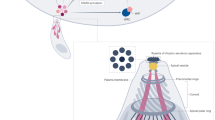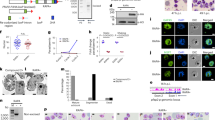Abstract
Analysis of gene function in apicomplexan parasites is limited by the absence of reverse genetic tools that allow easy and rapid modulation of protein levels. The fusion of a ligand-controlled destabilization domain (ddFKBP) to a protein of interest enables rapid and reversible protein stabilization in T. gondii. This allows an efficient functional analysis of proteins that have a dual role during host cell invasion and/or intracellular growth of the parasite.
This is a preview of subscription content, access via your institution
Access options
Subscribe to this journal
Receive 12 print issues and online access
$259.00 per year
only $21.58 per issue
Buy this article
- Purchase on Springer Link
- Instant access to full article PDF
Prices may be subject to local taxes which are calculated during checkout


Similar content being viewed by others
Change history
29 November 2007
Note: In the version of this article initially published, the labels in the bottom right image of Figure 2b were incorrect. The correct labels are shown in the image below. The error has been corrected in the HTML and PDF versions of the article.
Notes
Note: In the version of this article initially published, the labels in the bottom right image of Figure 2b were incorrect. The correct labels are shown in the image below. The error has been corrected in the HTML and PDF versions of the article.
References
Meissner, M., Agop-Nersesian, C. & Sullivan, W.J. Jr. Appl. Microbiol. Biotechnol. 75, 963–975 (2007).
Banaszynski, L.A., Chen, L.C., Maynard-Smith, L.A., Ooi, A.G. & Wandless, T.J. Cell 126, 995–1004 (2006).
Armstrong, C.M. & Goldberg, D.E. Nat. Methods advance online publication 11 November 2007 (doi:10.1038/nmeth1132).
Meissner, M., Schluter, D. & Soldati, D. Science 298, 837–840 (2002).
Soldati, D. & Boothroyd, J.C. Mol. Cell. Biol. 15, 87–93 (1995).
Meissner, M., Brecht, S., Bujard, H. & Soldati, D. Nucleic Acids Res. 29, e115 (2001).
Herm-Gotz, A. et al. EMBO J. 21, 2149–2158 (2002).
Lee, S.A., Mao, Y., Zhang, Z. & Wong, B. Microbiology 147, 1961–1970 (2001).
Wan, K.L., Carruthers, V.B., Sibley, L.D. & Ajioka, J.W. Mol. Biochem. Parasitol. 84, 203–214 (1997).
Morrissette, N.S. & Sibley, L.D. J. Cell Sci. 115, 1017–1025 (2002).
Mann, T., Gaskins, E. & Beckers, C.J. J. Biol. Chem. 12, 41240–41246 (2002).
Gaskins, E. et al. J. Cell Biol. 165, 383–393 (2004).
Acknowledgements
We thank B. Striepen (University of Georgia), D.L. Sibley (Washington University), V.B. Carruthers (Johns Hopkins School of Public Health), C.J. Beckers (The University of North Carolina) and D. Soldati (University of Geneva) for sharing reagents. We thank K. Matuschewski, G. Langsley and D. Goldberg for critically reading the manuscript, M. Rauch for technical assistance, and M. Kudryashev for help with image analysis. This work was funded by the BioFuture-Programm (grant 0311897) of the German ministry of science and education (BMBF).
Author information
Authors and Affiliations
Contributions
A.H.-G generated and analyzed parasites expressing ddFKBP-YFP,GFP-ddFKBP and ddFKBP-MyoA. C.A.-N. generated and analyzed parasites expressing ddFKBP-Rab11ADN, ddFKBP-YPT1 and ddFKBP-YPT1DN. S.M. performed live cell imaging. J.S.G. synthesized Shld1. T.J.W. was involved in designing and discussing this study. F.F. and M.M. initiated and guided this study.
Corresponding author
Supplementary information
Supplementary Text and Figures
Supplementary Figures 1–4, Supplementary Methods (PDF 4132 kb)
Supplementary Movie 1
Upregulation of DD-YFP upon addition of Shld1 (MOV 3185 kb)
Supplementary Movie 2
Downregulation of DD-YFP upon removal of Shld1 (MOV 2698 kb)
Rights and permissions
About this article
Cite this article
Herm-Götz, A., Agop-Nersesian, C., Münter, S. et al. Rapid control of protein level in the apicomplexan Toxoplasma gondii. Nat Methods 4, 1003–1005 (2007). https://doi.org/10.1038/nmeth1134
Received:
Accepted:
Published:
Issue Date:
DOI: https://doi.org/10.1038/nmeth1134
This article is cited by
-
The vacuolar iron transporter mediates iron detoxification in Toxoplasma gondii
Nature Communications (2023)
-
Regulation of eDHFR-tagged proteins with trimethoprim PROTACs
Nature Communications (2023)
-
Multi-omics analysis delineates the distinct functions of sub-cellular acetyl-CoA pools in Toxoplasma gondii
BMC Biology (2020)
-
Tunable light and drug induced depletion of target proteins
Nature Communications (2020)
-
Alveolar proteins stabilize cortical microtubules in Toxoplasma gondii
Nature Communications (2019)



